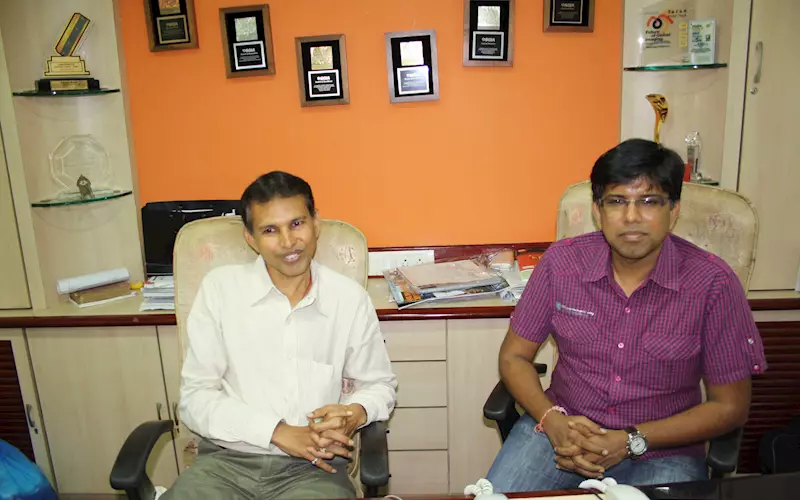The company undertakes water based printing, plastisol printing, discharge, flocking, high density, gel printing, H F welding on garments, flex printing, texture print, glitters / shimmer, foil printing, distressed look, process color photo printing on white garments, index color photo printing on dark garments, printing on highly stretch fabric, denims discharge, spray printing, combination of direct printing of decorative printing. “We do very special jobs such as two colour flock, foil, foil plus flocking, HD plus foil/flock which is difficult and only very few companies in India are doing this job,” says the Shethia brothers.
Adopt new technology
To grow in business, Shethia suggests to all printers to go for technology adoption. “Since, 1996-98, our focus was on capital investment and knowledge acquisition. Wherever I go I am attracted towards sophisticated technologies, especially in printing, as, we value innovation and quality,” says Sethia.
He recalls the name of Chimanbhai Mistry from whom he came to know about screen printing and how it is done in Germany and Europe. “I visited the foreign market, fashion and retail markets besides having the collection of books on fashion and creativity. We started learning more and more ever since FESPA opened up technology expositions.”
Infrastructure:
Tarun’s set-up facilitates co-existence of manual as well as sophisticated printing technology - imported automatic screen printing machines and most modern pre-press set up (Screen Making set up from Grafica). Tarun is also well-equipped with facilities for stretch transfers and low-temperature application transfers, the latter taking as little as two to three seconds in application.
Delighted customers:
“We have today business relations, directly with companies including Desigual, Diesel, Adidas, Armani, Arrow, Cherokee, Hanes, Disney, Liverpool, Pepe Jeans, Reebok, etc,” says Bharat Sethia. He says that a Hong Kong company, which was printing its garments elsewhere by paying a high price, gave them some samples. “Now they are very much satisfied that they have diverted all their requirements to our units. By this they are getting the printing at one-third of the cost done before, with the same quality.”
Quality raw materials
During the factory tour, Shethia highlighted the use of high-quality mesh, screen chemicals, Inks, water based inks, paper from the most reputed companies based in Europe and USA; and all other relevant high-end operational system. They employ techniques to produce plastisol based as well as water based transfer as per OekoTex 100 standards.
Design - a key element in garment printing:
“We have our own design and testing unit for fashions and textiles and this combination is unique and very rare,” says Shethia. The company has 15 well-trained designers, who can improvise on designs as per the requirements of customers within a short time. “Bulk of the jobs are own creativity and about 80% orders are received for our own designs. Others send their design but we give them suggestion, if required,” says Sethia.
With a talented team of designing and creativity and committed troupe of workmen, Tarun was able to maintain hinder-less production. “Due attention is paid to the overall personal grooming of team members with a view to facilitate, the individual as well as collective success. Each teammate is encouraged to be open-minded with ideas, delegated with power and is trained to shoulder the responsibility towards the execution of the projects, fortifying the process with intense behavioural programmes and systematic functional strategies,” reveals Sethia.
Transfer printing:
Tarun Printing is also specialised in manufacturing different types of heat transfers as per customers' requirements fulfilling different parameters such as washing fastness, softness, sharpness, stretch-ability and also formaldehyde-free prints and APEO-free prints.
Bharat Sethia says that though today again direct printing is in, “Transfers” are still the inevitable part of garment industry to fashion. “Transfers” are known for their advantages over the direct printing”. The affordable price, when small in size, simple process of attachment, heart winning and innovative designs, minimum wastage, easy to transport and long lasting durability; with these it could go beyond the limitations of direct printing, taking the market of printing on ride for more than a decade.
Awards: 200
It the SGIA's Golden Image Competition 2014, they bagged 13 awards with six gold, three silver, three bronze and one honourable mention under ten categories in textiles and garments printing. Interestingly, the company’s total awards received so far now stands at 205 (178 international and 26 national). “We finally hit Double 100's in awards. My first award was at FESPA for quality printing,” says Sethia.
He adds, “Participating in international competitions such as SGIA and FESPA is the only way to compare your quality level with other top level players in the field. This is also chance to do a self-analysis about your performance. When we win awards, we can pat on our own back, you get appreciation from others but that doesn’t mean we should take some rest from quality improvement. There is always further room for improvement else next time someone else will take over in quality. The awards come for all our efforts and time invested.”
And, lot of efforts – key to success:
When asked about their success, the Sethia brothers were quick to say that it was not easy(winning awards in international competitions): “It requires lot of efforts,” he concludes.











 See All
See All